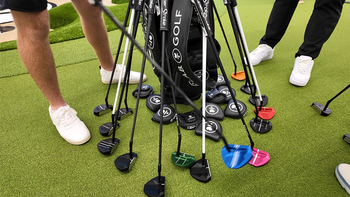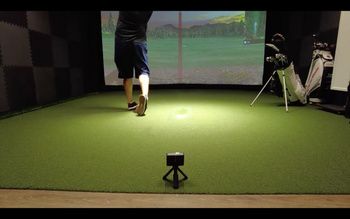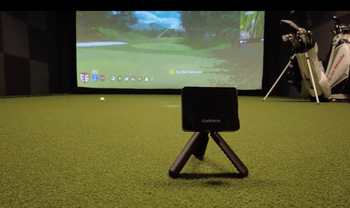The loft of a golf club is the angle between the clubface and the shaft, measured when the club sits in its normal address position. This angle points the clubface upward and is a critical factor in how the golf ball behaves after being hit.
Loft angles are measured in degrees. Clubs with more loft have higher degree measurements, while those with less loft have lower numbers. The main job of the loft is managing the golf ball's trajectory and spin. Clubs with higher loft angles launch the ball higher, with more backspin. This creates a steeper landing angle and less roll after landing. Lower lofted clubs launch the ball on a lower, more direct path with less backspin. These shots fly lower and roll farther after hitting the ground.
Choosing clubs with the best loft for your swing is critical for maximizing your distance and control on the course. Experiment with different lofts to find the combo that works for you. The right mix of trajectory and spin will have you hitting the ball farther and straighter in no time. Mastering loft angles is a key step in taking your golf game to the next level.
Table of Contents
Typical Loft Degrees for Different Golf Clubs
Each type of golf club is designed with a specific range of lofts to fulfill different roles in your bag. Here's a breakdown of the typical loft ranges you'll find:
Club Type |
Typical Loft Range |
|---|---|
Driver |
8-12 degrees |
3-wood |
13-16 degrees |
5-wood |
17-19 degrees |
2-iron |
18-20 degrees |
3-iron |
20-23 degrees |
4-iron |
23-26 degrees |
5-iron |
26-29 degrees |
6-iron |
29-32 degrees |
7-iron |
32-35 degrees |
8-iron |
35-38 degrees |
9-iron |
38-42 degrees |
Pitching wedge |
42-46 degrees |
Gap wedge |
46-51 degrees |
Sand wedge |
54-58 degrees |
Lob wedge |
58-64 degrees |
Putter |
2-4 degrees |
It's important to note that these are general ranges, and exact lofts can vary between manufacturers and models.
Factors Influencing Golf Club Loft
The ideal loft for your golf clubs depends on several key factors. Your skill level plays a big role - beginners usually do better with higher lofts that are more forgiving and get the ball in the air easier. Better players may prefer lower lofts for more control over their shots.
How fast you swing also matters a lot. Players with high swing speeds can use lower lofts and still get enough backspin, while slower swingers often need more loft to get the right launch.
The course conditions impact club selection, too. Higher lofts work better from soft fairways, so the ball doesn't bury in the turf. Low lofts can give you a bonus distance on firm ground.
So before you buy your next set of clubs, think about your game, your swing, and where you play. Dialing in the best loft setup will help you shoot lower scores and have more fun.
The Evolution of Golf Club Lofts
Golf club loft angles have undergone significant changes over the years. In the early days, golf clubs featured much higher lofts than modern clubs. A 9-iron from the 1970s typically had a loft of around 48 degrees, while today's 9-irons have lofts closer to 41 degrees.
This trend of progressively decreasing lofts, known as "loft jacking" or "loft creep," is primarily driven by manufacturers competing to produce longer-hitting irons. Lowering the loft allows them to advertise irons that hit the ball farther. However, this trend has also resulted in a compression of loft gaps between clubs, leading to potential issues with gapping and control for golfers.
The evolution of golf club lofts reflects the changing priorities and demands of the golf industry. While the pursuit of distance has been a major factor in loft changes, it is important for golfers to consider the potential trade-offs in terms of consistency and precision. Understanding the impact of loft variations can help golfers make informed decisions when selecting clubs that suit their individual playing styles and preferences.
Choosing the Right Loft for Your Game
Finding the right loft setup for your golf clubs is a personal process based on your swing and goals. Follow these steps to choose the best lofts:
Evaluate your skill level. Higher handicap golfers usually need more loft, while better players like less.
Think about your swing. Higher lofts help get the ball in the air if you need help, but less loft is good if you hit it too high.
Go to a professional club fitter. They use launch monitors and expertise to find the perfect lofts for your swing.
Adjustable Loft Technology
Adjustable loft technology is now a common feature in modern golf clubs, particularly drivers and fairway woods. This innovation lets golfers change the loft angle of their club by a few degrees up or down.
Manufacturers achieve adjustable loft by using a removable hosel or an adjustable sleeve where the shaft meets the clubhead. Golfers simply loosen a screw or rotate the sleeve to alter the club's loft.
Adjustable loft allows players to customize their clubs for various playing conditions or swing changes. However, some golfers may find the options overwhelming, and frequent adjustments could lead to inconsistent performance.
The Impact of Loft on Distance and Accuracy
Loft plays a critical role in how far and accurately you hit the golf ball. It can help optimize your launch conditions for maximum distance and control.
Loft impacts the launch angle (the height the ball takes off) and spin rate (the amount of backspin). Higher lofts increase both launch angle and spin rate, while lower lofts decrease them.
For most golfers, the ideal launch conditions for maximum distance involve a high launch angle with low spin. However, the optimal numbers vary based on factors like swing speed.
Lofts that are too high or low can lead to suboptimal launch conditions and loss of distance. Excessive loft can cause the ball to launch too high with too much spin, sacrificing distance and control. Insufficient loft can result in a low launch with not enough spin, causing the ball to fall out of the air too quickly.
Finding the right loft for your swing and desired ball flight is key to maximizing your potential on the golf course. Work with a professional club fitter to determine the ideal loft for your driver and other clubs.
Loft Gapping in Your Golf Bag
The right loft gaps between your golf clubs make a big difference in controlling distance and avoiding tricky yardage situations.
Proper loft gaps mean each club goes a specific distance with uniform spacing. This gives you the right club for any shot to swing confidently.
Track your club distances over several rounds to figure out your loft gaps. Big inconsistencies or spaces between clubs could mean you need to tweak the lofts or swap out some sticks.
Dialing in your loft gaps takes some work, but it's worth it. Even yardage jumps, and a club for every distance simplifies shot choices and sets you up to shoot lower scores.
If your loft gaps are off, don't ignore it. Test some loft adjustments or demo new clubs to get your set nicely spaced out. Your game will thank you!
Custom Fitting and Loft Optimization
Custom club fitting is one of the best ways to get optimal lofts for your swing.
Professional club fitters use launch monitors and know-how to pick the ideal lofts based on how you swing, the ball flight, and what you want to achieve.
You can tweak the lofts yourself with a loft and lie machine, but it's risky. Wrong adjustments can mess up your game.
Common Misconceptions About Golf Club Loft
Many golfers have misconceptions about golf club loft that can hurt their game.
A lower loft doesn't always mean more distance. Players with slower swing speeds often lose yardage with lofts that are too low.
Strongly lofted clubs aren't a magic bullet. They might give you extra distance but can also be tougher to hit well. Loft gaps between clubs can get messed up too.
Advanced Concepts in Golf Club Loft
Golf club loft is a complex topic with many advanced concepts for those who want to understand it more deeply.
Static loft is the loft angle of the clubface when the golf club is at rest. Dynamic loft is the actual loft angle at the moment the club strikes the ball. Many factors affect dynamic loft, including the flexibility of the shaft, the path of the swing, and whether the club is descending, level, or ascending at impact.
Club head design also plays a major role in how the ball launches and flies. Shifting the center of gravity lower and farther back from the clubface tends to increase dynamic loft and ball flight, even if the static loft remains the same. Subtle changes in face thickness and shape can also alter ball flight independently of the stated loft.
Loft Considerations for Different Types of Golfers
Golfers' loft needs vary based on their skill level, swing speed, and goals on the course. Beginners usually do best with higher lofts, which launch the ball higher and straighter. Intermediate players can start using lower lofts to shape shots and control ball flight. Low handicappers often prefer the workability of low-lofted clubs, but their ideal setup still depends on their unique swing. Seniors and juniors, who usually swing slower, get more carry distance from higher lofts. The key is picking lofts that optimize launch conditions for your swing to hit solid, consistent shots. Clubfitting from a pro can help dial in the right loft specs for any golfer's game.
The Future of Golf Club Loft Technology
Golf technology keeps progressing, bringing new possibilities for loft design and tuning. Some golf equipment brands are testing innovative materials and manufacturing methods that enable thinner, springier clubfaces. Thinner faces can boost ball velocity and carry distance, even with higher-lofted clubs like short irons and wedges. Golf companies may start offering more personalized loft setups tailored to each golfer's swing metrics and ball flight tendencies, using data from club fitting sessions and launch monitors. Speaking of launch monitors, as they become cheaper and more widely available, more players will have the chance to dial in their lofts and maximize their potential on the course.
The future of golf club design is all about pushing the boundaries of what's possible in terms of speed, launch angle, and spin rate optimization. Breakthroughs in materials science and manufacturing could lead to previously unimaginable loft configurations that help every golfer - from tour pros to weekend warriors - hit the ball farther and straighter. As golf equipment companies invest in R&D and leverage big data, machine learning, and advanced simulations, they'll unlock new frontiers in club design and fitting that could revolutionize the game as we know it. The next generation of golf clubs will likely feature smart technologies that adapt to each player's unique swing characteristics and course conditions in real-time. It's an exciting time to be a golf gearhead, that's for sure.
Conclusion
Loft is just one of many factors in club design, but it's a biggie. Picking the right lofts, and learning to flight the ball up and down as needed, are skills that help anyone shoot lower scores. Beginners and tour pros alike can benefit from a little loft management.







